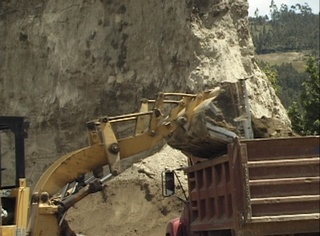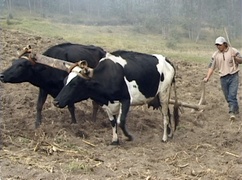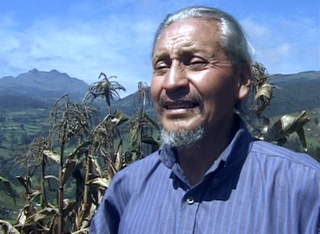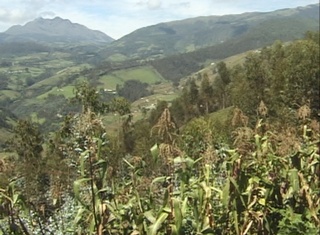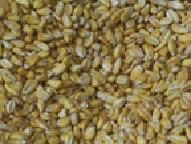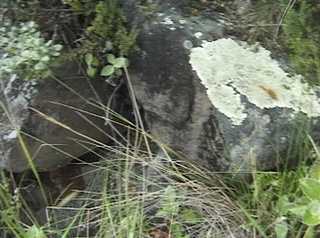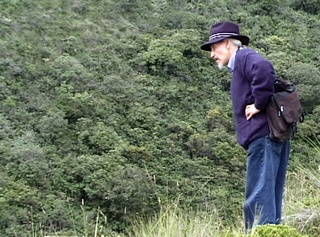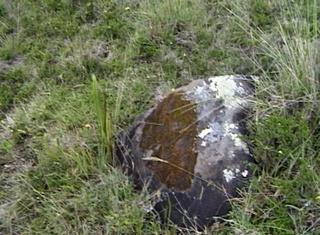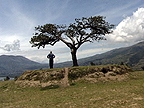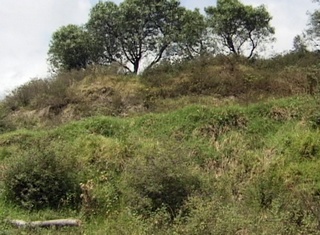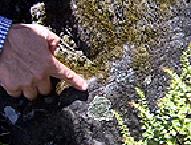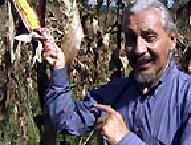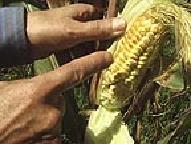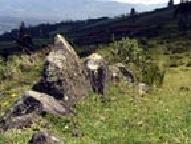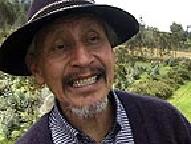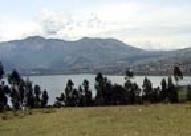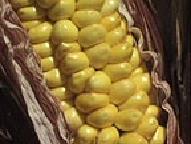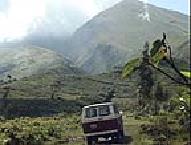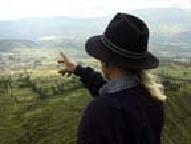There are many sacred sites in the Otavalo area, the most important being what is now known as “the Lechero”. What happened to the great temples that were once located on these sites? Little remains as proof except the geographical positions.
The Ancients of Otavalo carved great canals into the mountainsides to direct and funnel water to specific areas during rainy seasons. Sr. Hernan Castro speculates and theorizes in yet another excerpt from our video collaboration .
My present video project is a study of an advanced civilization living in the Otavalo Valley long before the arrival of the Incas or the Spanish. The basis of the culture was the production of Maize, that is, the sacred plant of Corn, as explained by Sr. Hernan Castro.
And yet another excerpt from a video project collaboration with the knowledgeable Hernan Castro, Otavalan historian. Sr. Castro points out examples in the Quechua language that reflect the origins of the culture of Maize in Otavalo.
As we began our research for this video we were shocked to discover that a major Tola, that is, a Sacred Ceremonial Site, in the center of Otavalo was being systematically destroyed to build a house. Sadly, no one was concerned, not even city hall.
More from Sr. Hernan Castro about the culture of Maize and how the American civilization of the past revolved around its cultivation. As we celebrate the Dia de Difuntos, Sr. Hernan speaks of the significance of Maize during these rituals.
OTAVALOVIDEOS.COM The Culture of Maize
The Pyramids of Otavalo w/ Sr. Hernan Castro
Pyramids and Temples of Otavalo w/ Sr. Hernan Castro
The Ancient Ruins of Otavalo w/ Sr. Hernan Castro
The Culture of Maize “Water Engineers” w/ Sr. Hernan Castro
The Ancient Ruins of Otavalo w/ Sr. Hernan Castro
Now that the maize has been harvested it is once again time to prepare the fields for planting corn and beans in September. The indigenous farmers of Otavalo continue to plow and hoe the earth by hand or with oxen. Tractors are for rent, but very expensive.
This is the time of year for the third harvest of corn planted last October. Maize is still a very important factor in the lives of the Otavalo campesino! The maize will be dried and ground into flour or stored and roasted slowly on ceramic plates to make tostado.
Preparing the Fields
The Harvest of Maize in Otavalo
The Culture of Maize in Otavalo w/ Sr. Hernan Castro
The Culture of Maize in Otavalo w/ Sr. Hernan Castro
The Culture of Maize in Otavalo w/ Sr. Hernan Castro
My present OtavaloVideos project is a collaboration with Sr. Hernan Castro, Otavalan historian. We have been led to the site of a sacred temple by several “ruminahuis”, the “stone eyes of the mountain”, markers placed by the ancient Otavalos.
My present OtavaloVideos project is a collaboration with Sr. Hernan Castro, Otavalan historian. During the conquest, Catholic priests destroyed temples overlooking the Otavalo valley. Little remains as proof except for the calculated placement of ceremonial stones.
The Ancient Ruins of Otavalo w/ Sr. Hernan Castro
Only the stones that formed the foundations remain of great temples that overlooked the Otavalo valley. Sr. Hernan Castro takes us higher and deeper into the complex of ceremonial sites near the Indigenous village of Quinchuqui.
All otavalovideos.com videos are owned and copyrighted 2019 by Frank M. Kiefer. Reproduction is prohibited. All rights reserved.
If you have any questions please write to videos@otavalovideos.com
If you have any questions please write to videos@otavalovideos.com

Little remains as proof of the pyramids, or Tolas, in Otavalo except the geographical positions. These Tolas have been systematically destroyed over the years. Sr. Hernan Castro speaks of the main pyramid that we now know was the ceremonial center of Otavalo.
More evidence of destroyed and abandoned structures is uncovered during a casual search of this ancient ceremonial site. Worked stones are strewn over several acres, an area totally forgotten and abandoned.
The Pyramids of Otavalo w/ Sr. Hernan Castro
The Ancient Ruins of Otavalo w/ Sr. Hernan Castro
The culture of the ancient Otavalos revolved around the cultivation of Maize. Maize still provides a wide variety of foods throughout the year. Sr. Hernan Castro speaks of these many products in this outtake of our present video project.
As we wind down our production, a video collaboration touching upon the ancient cultures of Otavalo, Sr. Hernan Castro, Otavalo historian, in his final interview, speaks of the relationship between the human beings, the cultivation of Maize and the Universe.
The Culture of Maize w/ Sr. Hernan Castro
The Ancient Ruins of Otavalo w/ Sr. Hernan Castro
Distribution of land and its measurement during pre Incan times is the subject discussed by Sr. Hernan Castro in this video documentary that we are producing and hope to complete soon! We have discovered extensive stone ruins within a few kms. of Otavalo.
What is Andean Cosmovision?
This is another fascinating chapter of our video collaboration in preparation for next week’s first annual Video Festival of Peguche. The volcanic lakes in the Otavalo area were sacred sites. The ancients studied the stars in these “mirrors of the sky”.
The evolution of the Maize plant and its cultivation by humans in the Andes is discussed by Sr. Hernan Castro, Otavalo historian, in our video collaboration documenting the ancient culture of Otavalo.
The Culture of Maize w/ Sr. Hernan Castro
The Culture of Maize w/ Sr. Hernan Castro
The Ancient Culture of Otavalo w/ Sr. Hernan Castro
Extensive ruins of ancient ceremonial sites, abandoned for a thousand years, sit high above Otavalo. I am still agonizing (!) with a final version of this video collaboration with Sr. Hernan Castro. Until I do finish, look for other chapters on these pages.
A Calcique was the community leader in ancient times. The more important the Calcique, the higher the ceremonial site he ruled from. Join Sr. Hernan Castro in this video collaboration outtake and "Imagine how it was to be Calcique of Otavalo..."
The Ancient Culture of Otavalo w/ Sr. Hernan Castro





















Now that the maize has been harvested it is once again time to prepare the fields for planting corn and beans in September. The indigenous farmers of Otavalo continue to plow and hoe the earth by hand or with oxen. Tractors are for rent, but very expensive.
This is the time of year for the third harvest of corn planted last October. Maize is still a very important factor in the lives of the Otavalo campesino! The maize will be dried and ground into flour or stored and roasted slowly on ceramic plates to make tostado.
My present video project is a study of an advanced civilization living in the Otavalo Valley long before the arrival of the Incas or the Spanish. The basis of the culture was the production of Maize, that is, the sacred plant of Corn, as explained by Sr. Hernan Castro.
More from Sr. Hernan Castro about the culture of Maize and how the American civilization of the past revolved around its cultivation. As we celebrate the Dia de Difuntos, Sr. Hernan speaks of the significance of Maize during these rituals.
And yet another excerpt from a video project collaboration with the knowledgeable Hernan Castro, Otavalan historian. Sr. Castro points out examples in the Quechua language that reflect the origins of the culture of Maize in Otavalo.
As we began our research for this video we were shocked to discover that a major Tola, that is, a Sacred Ceremonial Site, in the center of Otavalo was being systematically destroyed to build a house. Sadly, no one was concerned, not even city hall.
There are many sacred sites in the Otavalo area, the most important being what is now known as "the Lechero". What happened to the great temples that were once located on these sites? Little remains as proof except the geographical positions.
The Ancients of Otavalo carved great canals into the mountainsides to direct and funnel water to specific areas during rainy seasons. Sr. Hernan Castro speculates and theorizes in yet another excerpt from our video collaboration .
My present OtavaloVideos project is a collaboration with Sr. Hernan Castro, Otavalan historian. We have been led to the site of a sacred temple by several “ruminahuis”, the “stone eyes of the mountain”, markers placed by the ancient Otavalos.
Only the stones that formed the foundations remain of great temples that overlooked the Otavalo valley. Sr. Hernan Castro takes us higher and deeper into the complex of ceremonial sites near the Indigenous village of Quinchuqui.
My present OtavaloVideos project is a collaboration with Sr. Hernan Castro, Otavalan historian. During the conquest, priests destroyed temples overlooking the Otavalo valley. Little remains as proof except for the calculated placement of ceremonial stones.
Little remains as proof of the pyramids, or Tolas, in Otavalo except the geographical positions. These Tolas have been systematically destroyed over the years. Sr. Hernan Castro speaks of the main pyramid that we now know was the ceremonial center of Otavalo.
More evidence of destroyed and abandoned structures is uncovered during a casual search of this ancient ceremonial site. Worked stones are strewn over several acres, an area totally forgotten and abandoned.
The culture of the ancient Otavalos revolved around the cultivation of Maize. Maize still provides a wide variety of foods throughout the year. Sr. Hernan Castro speaks of these many products in this outtake of our present video project.
As we wind down our production, a video collaboration touching upon the ancient cultures of Otavalo, Sr. Hernan Castro, Otavalo historian, in his final interview, speaks of the relationship between the human beings, the cultivation of Maize and the Universe.
Distribution of land and its measurement during pre Incan times is the subject discussed by Sr. Hernan Castro in this video documentary that we are producing and hope to complete soon! We have discovered extensive stone ruins within a few kms. of Otavalo.
To be human in the ancient culture of Otavalo was to understand the immensity of the universe and to live by the patterns and cycles of the sun and stars. Sr. Hernan Castro, Otavalo historian, discusses the Cosmovision of the Americas in this video collaboration.
To be human in the ancient culture of Otavalo was to understand the immensity of the universe and to live by the patterns and cycles of the sun and stars. Sr. Hernan Castro, Otavalo historian, discusses the Cosmovision of the Americas in this video collaboration.
This is another fascinating chapter of our video collaboration in preparation for next week’s first annual Video Festival of Peguche. The volcanic lakes in the Otavalo area were sacred sites. The ancients studied the stars in these “mirrors of the sky”.
The evolution of the Maize plant and its cultivation by humans in the Andes is discussed by Sr. Hernan Castro, Otavalo historian, in our video collaboration documenting the ancient culture of Otavalo.
Extensive ruins of ancient ceremonial sites, abandoned for a thousand years, sit high above Otavalo. I am still agonizing (!) with a final version of this video collaboration with Sr. Hernan Castro. Until I do finish, look for other chapters on these pages.
OTAVALOVIDEOS.COM The Culture of Maize
OTAVALOVIDEOS.COM The Culture of Maize
Preparing the Fields
The Harvest of Maize in Otavalo
The Culture of Maize in Otavalo w/ Sr. Hernan Castro
The Culture of Maize in Otavalo w/ Sr. Hernan Castro
The Culture of Maize in Otavalo w/ Sr. Hernan Castro
The Pyramids of Otavalo w/ Sr. Hernan Castro
Pyramids and Temples of Otavalo w/ Sr. Hernan Castro
The Culture of Maize “Water Engineers” w/ Sr. Hernan Castro
The Ancient
Ruins of Otavalo w/ Sr. Hernan Castro
Ruins of Otavalo w/ Sr. Hernan Castro
The Ancient Ruins of Otavalo w/ Sr. Hernan Castro
The Ancient Ruins of Otavalo w/ Sr. Hernan Castro
The Pyramids of Otavalo w/ Sr. Hernan Castro
The Ancient Ruins of Otavalo w/ Sr. Hernan Castro
The Culture of Maize w/ Sr. Hernan Castro
The Culture of Maize
w/ Sr. Hernan Castro
w/ Sr. Hernan Castro
The Culture of Maize w/ Sr. Hernan Castro
The Ancient Ruins of Otavalo w/ Sr. Hernan Castro
What is Andean Cosmovision?
The Culture of Maize w/ Sr. Hernan Castro
The Ancient Culture of Otavalo w/ Sr. Hernan Castro
The Ancient Culture of Otavalo w/ Sr. Hernan Castro
The Culture of Maize w/ Sr. Hernan Castro
The Culture of Maize w/ Sr. Hernan Castro
A Calcique was the community leader in ancient times. The more important the Calcique, the higher the ceremonial site he ruled from. Join Sr. Hernan Castro in this video collaboration outtake and "Imagine how it was to be Calcique of Otavalo..."
